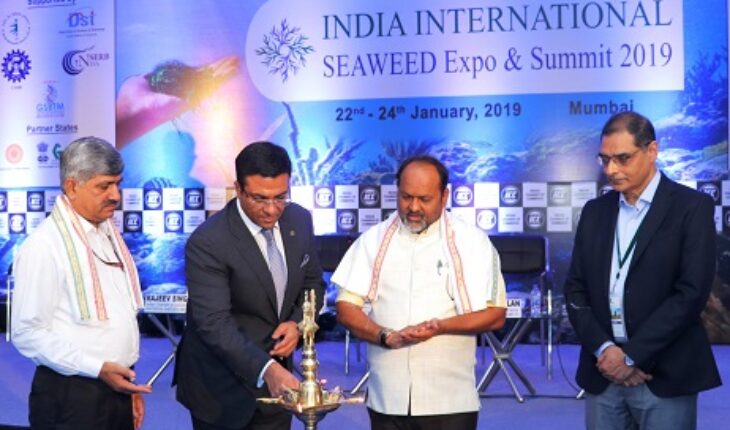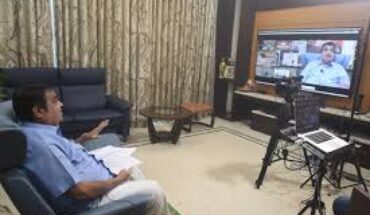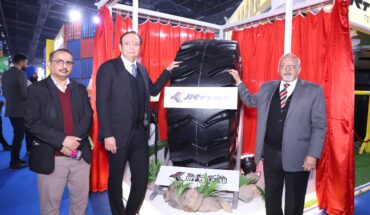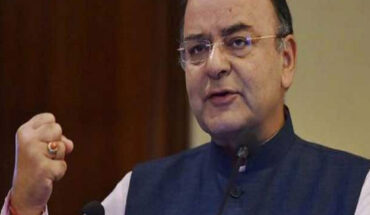The ‘India International Seaweed Expo & Summit’ — the first-ever, comprehensive initiative focusing on the +Seaweed+ sector – began in Mumbai today with the Maharashtra Minister for Fisheries, Mahadev Jagannath Jankar highlighting the Maharashtra Government’s initiative in providing training to youth and women alongside developing infrastructure for the Seaweed Industry in the state.
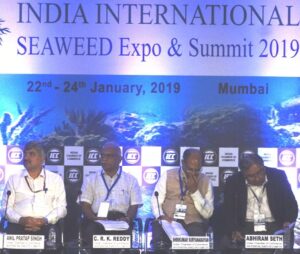 The three-day Expo is expected to explore the ocean of opportunities in this sunrise sector that holds immense potential in creating new business opportunities for private sector companies, coastal farmers, R&D Institutions, among others.
The three-day Expo is expected to explore the ocean of opportunities in this sunrise sector that holds immense potential in creating new business opportunities for private sector companies, coastal farmers, R&D Institutions, among others.
Maharashtra’s Sassoon Dock highlighted annual fish landing of about 49,000 tonnes and noted that, with increasing imposition of international EU standards, fish hygiene became an essence and pre-requisite. The Maharashtra Government has mandated the “Maharashtra Fisheries Development Corporation (MFDC)” to renovate and modernize the existing facilities at Sassoon Dock to make it stake-holders-friendly, achieve better fish hygiene and improve traffic conditions – thereby improving the port’s efficiency.
Describing the current development of Seaweed Industry in India and globally at US$ 26 billion globally, Mayank Jalan, Sr. Vice President, ICC said India had huge production potential alongside a primary knowledge gap in terms of how to enter into this industry, export assistance etc.
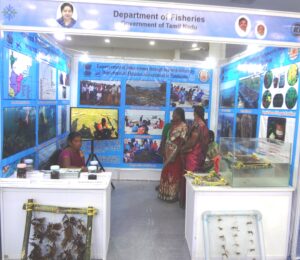 Tapan K Chattopadhyay, Deputy Director, Capacity Building Initiatives, Indian Chamber of Commerce, told media here that the Seaweed sector has been identified as a priority sector by the Indian Government including the Prime Minister Narendra Modi under the “Make In India” Initiative. Seaweed has applications in various industries like Food, Bio-Fertiliser, Cosmetics, Pharmaceuticals, Chemicals and Fertiliser, he said.
Tapan K Chattopadhyay, Deputy Director, Capacity Building Initiatives, Indian Chamber of Commerce, told media here that the Seaweed sector has been identified as a priority sector by the Indian Government including the Prime Minister Narendra Modi under the “Make In India” Initiative. Seaweed has applications in various industries like Food, Bio-Fertiliser, Cosmetics, Pharmaceuticals, Chemicals and Fertiliser, he said.
“The Indian economy will immensely benefit by developing the domestic Seaweed industry in terms of reduction of imports, new investments, start-ups, coastal India’s economic development and huge employment opportunities for seaweed farmers,” he said while stating that the event’s participants included 15 international seaweed experts and 14 national speakers along with Indian corporates and all stakeholders, besides Coastal States like Maharashtra, Gujarat, Tamil Nadu, Odisha etc.
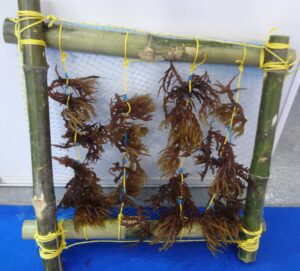 Describing the seaweed sector as a globally-billion-dollar industry, he said “Seaweed is basic material with enormous vitamin potential for industries like bio-fertiliser, cosmetics, textiles, laminations, but India has a very unorganized sector in this regard — despite having a suitable, lengthy coastal belt for seaweed cultivation in the rough seas and even shallow, stagnant water — including ponds (which has been proved by Israel).”
Describing the seaweed sector as a globally-billion-dollar industry, he said “Seaweed is basic material with enormous vitamin potential for industries like bio-fertiliser, cosmetics, textiles, laminations, but India has a very unorganized sector in this regard — despite having a suitable, lengthy coastal belt for seaweed cultivation in the rough seas and even shallow, stagnant water — including ponds (which has been proved by Israel).”
However, the seaweed business – which has been exploited successfully by China to become the biggest such exporter with Rs 61,000 crores in exports – can generate huge employment for all related industries in India while reducing the Government Exchequer’s expenditure on imports. “Seaweed is environment-friendly where creation of more algae in water ensures the water’s cleanliness. Out of the globally 800 seaweed species, India has around 200 seaweed species but still imports Rs 100 crores of Seaweed for use in the textile industry, nutrition products,” he said while noting that Seaweed – which is on Prime Minister Narendra Modi’s agenda — is not being pushed due to unknown reasons.”
Pointing out that the seaweed sector faces some policy and regulatory hurdles for which the Summit would deliberate on for seeking suitable solutions, he said the Expo would also facilitate business tie-ups, MOUs, trade deals, technology transfer, alongside over 150 B2B meetings set up by the organisers.
 Professor CRK Reddy, DBT-ICT Centre for Energy Biosciences, highlighted the need for: Facilitating a Government-research-industry interface with both Indian and International research and industry players; Discussing important and emerging issues relating to the Seaweed industry like developments, Government policies and proposals for West, South and East India; Advance new technologies and applications with help from Research Institutes; Explore applications in the Agriculture, Neutraceuticals, food, pharmaceuticals, fertilizer, biostimulant and textile industries; promote interactions between the international technical experts, national scientists, industry experts, entrepreneurs, investors and government agencies; facilitate collaborations between Indian and overseas companies; and New investment for global manufacturing.
Professor CRK Reddy, DBT-ICT Centre for Energy Biosciences, highlighted the need for: Facilitating a Government-research-industry interface with both Indian and International research and industry players; Discussing important and emerging issues relating to the Seaweed industry like developments, Government policies and proposals for West, South and East India; Advance new technologies and applications with help from Research Institutes; Explore applications in the Agriculture, Neutraceuticals, food, pharmaceuticals, fertilizer, biostimulant and textile industries; promote interactions between the international technical experts, national scientists, industry experts, entrepreneurs, investors and government agencies; facilitate collaborations between Indian and overseas companies; and New investment for global manufacturing.
“The Seaweed industry has a policy-making sector, industry and overseas business but there is need for expansion of this industry in India as – despite six decades of research here – the industry still needs efforts to make it ‘vibrant.’ There are many countries that think and work along these lines, which need to be streamlined for development in India’s seaweed sector,” he said while urging for a dedicated, unified policy system for India, which is emerging as a prospective leading player and needs evolution of some guidelines from the dignitaries at this event.
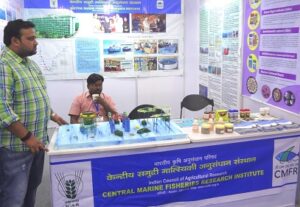 Dr Shrikumar Suryanarayan, Managing Director, Sea Energy Pvt ltd., said international prices of Seaweed were double that of India. “While international seaweed prices are US$8.5 per kilo, Indian seaweed producers get barely US$ 3.5 per kilo,” he said.
Dr Shrikumar Suryanarayan, Managing Director, Sea Energy Pvt ltd., said international prices of Seaweed were double that of India. “While international seaweed prices are US$8.5 per kilo, Indian seaweed producers get barely US$ 3.5 per kilo,” he said.
Urging for the Ministry of Commerce to be taken on board in dealing with the Seaweed prices issue, Dr Anil Pratap Singh, Advisor (Agriculture), NITI Aayog, Government of India said the Seaweed industry featured 14-15 seaweed companies and NITI Aayog is inviting proposals from the Seaweed Industry for discussions. Besides these multiple seaweed stakeholders being different from Agricultural cultivators, the Government needs to double these exports by removing from it the impediments and bottlenecks through involvement of the National Authority in dealing with the challenges involved, he said.
Pointing out that this Industry would benefit through adding value domestically, he said India’s total general exports were Rs 2.5 lakh crores last year with a good future envisioned for growth. The role of the Ministry of Environment and Biodiversity would be looked into also, even as things kept moving at the Government end and efforts to eradicate challenges would continue, though creation of new entities is a difficult task, he said.
When an audience member pointed out that the necessary funds are being deployed for this industry in various states of India, Abhiram Seth, Managing Director, AquAgri Processing Pvt Ltd, said such funds from the Central Authority were going to these States, who however did not use these funds. “There are teething, understanding issues like the CRZ Act and other laws, but flexibility in these matters could provide solutions that could lead to scaling-up of this industry sector. Having a scientific body driving this initiative is a great idea, but creating more institutions causes more impediments. So free this industry from such institutions by creating a conducive environment and then see how it works,” Seth added.
“A problem facing the Seaweed industry is that if even if a single NRI Person is member on a Company’s Board, then that company is considered a foreign company under the Biodiversity Act,” an audience member lamented, while another member pointed out that “All capital for Startups come from Silicon Valley.” However, a speaker emphasized that the Biodiversity Act had been put into place for preventing Bio-Piracy.
Highlighting India’s unique ecosystem, another speaker narrated the case of a scientist who came to India all the way from the USA – just to take away a +molecule+ of a tree that is suitable for ‘Nuclear Sites’. Another person urged for a policy that would ensure exports of those items that benefitted farmers in their prices.
Meanwhile, the Expo participants displayed some surprises. Women from Tamil Nadu’s coastline showcased their skills in farming underwater three species of Seaweed (Kappaphyces alvarezii, Gehdiella acerosa and Gracilaria edulis) in the sea waters of 19 villages in Tuticorin, Tirunelveli and Ramnathapuram. Abdul Kadher, Assistant Director, Tamil Nadu Fisheries, said seaweed culturing is done on rafts and grows quickly, while these women do farming including harvesting in sea depths between 8-10 feet by using 3,000 seaweed algae cultivation rafts (that are 100% subsidized with also seeds and other related items) with annual harvests being 10,000 kilos and dried production being 1,000 kilos.
ICAR-Central Marine Fisheries Research Institute (CMFRI) Scientist Dr B Johnson highlighted IMTA-designed rafts with 75 kgs seaweed per raft for span of four cycles that comprised each cycle of 45 days and also included cages with 750 COBIA fish fingerlings, thus generating additional revenue through increased yields.
The ICC took support from DST, MOFPI, NBA and SCIR in organizing this event, which witnessed participation of Ministries of Agriculture, Chemicals and Fertilisers, Biotechnology, Science and Technology, Skill Development and Environment, Integrated Nutrition Management, Fisheries Departments of Goa, Tamil Nadu, Kerala, Maharashtra, West Bengal, Andhra Pradesh, Karnataka, Gujarat and Orissa. Seaweed companies came from Japan, Korea, Malaysia, Indonesia, Philippines, Sri Lanka, China, USA, Canada, Norway, Germany, Netherlands, besides Seaweed researchers and scientists.


